Chemical Peel Treatment
Chemical Peel in Ware
At Beauty Bar Salon in the heart of Ware, Hertfordshire, we believe that every individual deserves to feel confident and beautiful in their own skin. That’s why we’re excited to introduce you to our transformative chemical peel treatments. We are dedicated to helping you rediscover your radiant self, addressing common skin concerns like aging, wrinkles, acne, and sun-induced skin discolorations.
Timeless Beauty with Anti-Aging Solutions
Are you seeking the secret to timeless beauty? Our anti-aging chemical peels are designed to turn back the clock, rejuvenating your skin and reducing the signs of aging. These treatments stimulate collagen production, promoting a firmer and more youthful complexion. Say goodbye to fine lines and wrinkles and embrace a more youthful version of yourself.
Unveil a Flawless Complexion with Acne Treatments
We understand the emotional toll that acne can take on your confidence. Our specialized chemical peels for acne treatment target the root causes of blemishes. By exfoliating clogged pores and reducing inflammation, we pave the way for clearer, healthier skin. Let our expert team guide you on your journey to acne-free confidence.
Erase Sun Spots and Skin Discoloration
Sunspots and skin discoloration can mar an otherwise flawless complexion. Our chemical peel treatments are your path to a brighter, more even skin tone. They effectively reduce the appearance of sunspots and freckles, helping you regain a smooth, radiant look. The sun may have left its mark, but we can help you reclaim your skin’s natural beauty.
At Beauty Bar Salon, we’re not just a salon; we’re your partners in enhancing your natural beauty. Our chemical peel treatments are as unique as you are, tailored to your specific needs and skin type. Step into our sanctuary of self-care and let us pamper you with treatments that reveal your true, authentic beauty.
Book your chemical peel appointment at Beauty Bar Salon in Ware, Hertfordshire, and experience a world of difference in your skin and self-confidence. Your journey to ageless, wrinkle-free, acne-free, and sunspot-free skin begins with us.
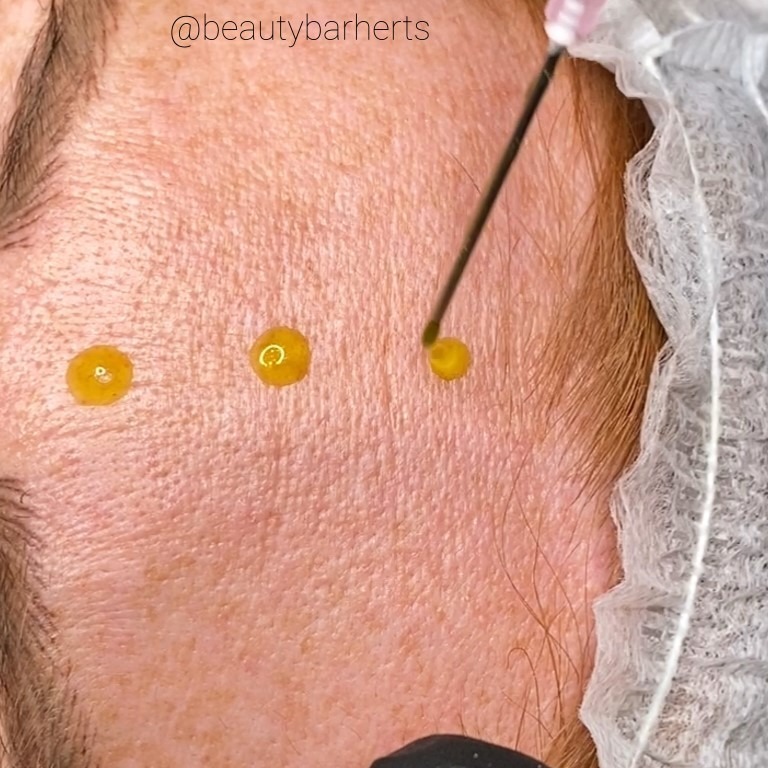
Chemical Peel FAQ's
What a chemical peel is and how Chemical Peels work to Transform Your Beauty?
In the quest for flawless skin, chemical peels have emerged as a popular solution. But what exactly is a chemical peel, and how does it work its magic? We will demystify the science behind chemical peels, shedding light on their different types and how they address various skin conditions, from acne to collagen boost.
What is a Chemical Peel?
A chemical peel is a cosmetic procedure designed to improve the texture and appearance of the skin. It’s an exfoliation process that utilizes a specially formulated solution to remove the outermost layer of damaged skin. As a result, it reveals a smoother, rejuvenated complexion beneath.
How Does a Chemical Peel Work?
The mechanism of a chemical peel is elegantly simple. The chosen solution, typically an acid, is applied to the skin’s surface. This acid works by loosening the bonds between the old, damaged skin cells. As these cells break free, they gently peel away, leaving room for fresh, new skin to emerge.
Different Types of Chemical Peels
Chemical peels come in various forms, each tailored to address specific skin concerns. Here are a few of the most common types:
Superficial Peels: Ideal for brightening dull skin, these peels are the mildest option. They exfoliate the outermost layer without causing visible peeling.
Medium Peels: Effective for mild to moderate skin imperfections, medium peels penetrate deeper into the skin, stimulating collagen production and reducing fine lines and sun damage.
Deep Peels: Reserved for more severe concerns, deep peels offer significant improvements but require a longer recovery period. They target deep wrinkles, scars, and pigment irregularities.
Tailored Solutions for Diverse Skin Issues
Acne Treatment: Chemical peels with salicylic acid or glycolic acid can effectively treat acne by exfoliating clogged pores and reducing inflammation.
Collagen Boost: Peels containing trichloroacetic acid (TCA) or phenol stimulate collagen production, helping to firm and plump the skin.
Sun Damage and Pigmentation: Chemical peels can reduce the appearance of sunspots, freckles, and uneven pigmentation, revealing a more even-toned complexion.
Skin Peeling: Not Always Mandatory
One common misconception about chemical peels is that they always result in visible skin peeling. In reality, only deeper peels are likely to lead to peeling, redness, and some downtime. Superficial peels, while still effective, may not cause noticeable peeling, making them a more convenient option for those with busy lifestyles.
Chemical peels are versatile and highly effective tools in the pursuit of healthier, radiant skin. Tailored to your unique skin needs, these treatments offer a customizable solution for a wide range of skin concerns. Whether you’re seeking an acne remedy, a collagen boost, or an overall skin rejuvenation, a chemical peel can be the key to unlocking your skin’s true potential. Consult us today to determine the right chemical peel for you and embark on a journey to rediscover your radiant beauty.
Demystifying Chemical Peels: Are They Painful?
The allure of radiant, rejuvenated skin often comes hand in hand with questions about the process. Among the common inquiries is whether chemical peels are painful. Let’s delve into the world of chemical peels to demystify the sensations involved, ensuring you’re well-prepared and confident on your journey to skin transformation.
Chemical peels are a versatile and effective cosmetic procedure designed to refresh and revitalize your skin. They work by exfoliating the outermost layer of skin, revealing a smoother, more youthful complexion beneath. The degree of discomfort associated with chemical peels can vary based on several factors.
Mild Discomfort: For many, the sensation of a chemical peel is akin to a mild tingling, warmth or stinging. This discomfort typically occurs during the application of the peel solution but subsides quickly as the procedure progresses.
Depth Matters: The level of discomfort depends on the depth of the peel. Superficial peels are generally less uncomfortable than medium or deep peels, which may cause more pronounced sensations.
Post-Peel Recovery: After the procedure, it’s common to experience some redness and tightness, but this is typically temporary and manageable. Deeper peels may involve more noticeable side effects during recovery.
Before the procedure a numbing cream may be applied to minimize any potential discomfort. Additionally, your technician will use their expertise to select the appropriate peel strength for your unique skin type and desired outcome, further reducing discomfort.
It’s important to remember that any brief discomfort associated with chemical peels is a small price to pay for the radiant, refreshed skin that awaits you. The peeling sensation is often seen as an indicator that the peel is working its magic, and it’s a temporary phase that leads to a more youthful, even-toned complexion.
The level of discomfort experienced during a chemical peel can vary from person to person, primarily based on the depth of the peel and individual pain thresholds. The sensation is generally mild and well-tolerated, with skincare professionals taking every precaution to ensure your comfort. The remarkable transformation and enhanced confidence that follow make the journey well worth the occasional tingling or stinging. Beauty awaits on the other side of that peel!
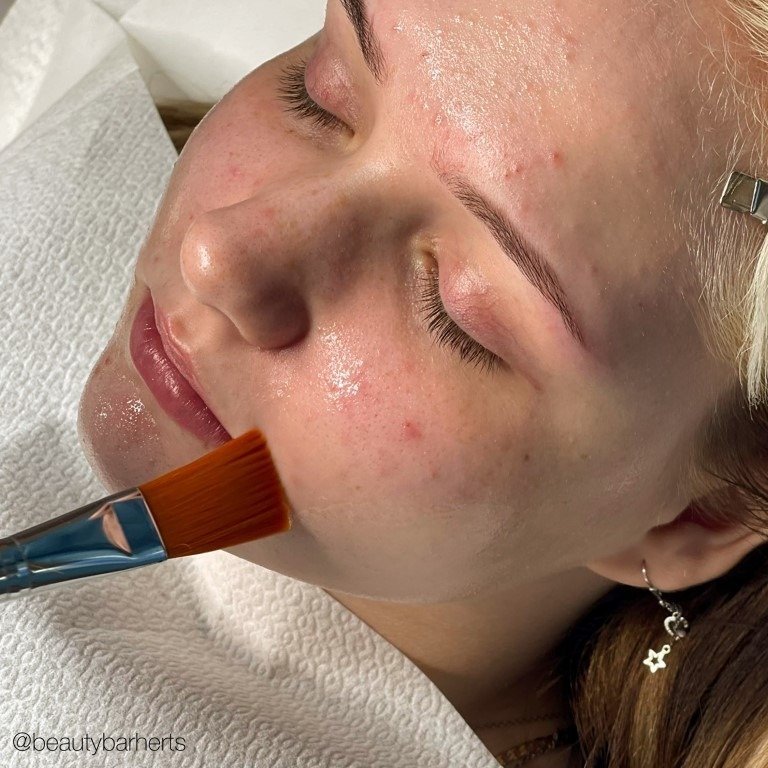
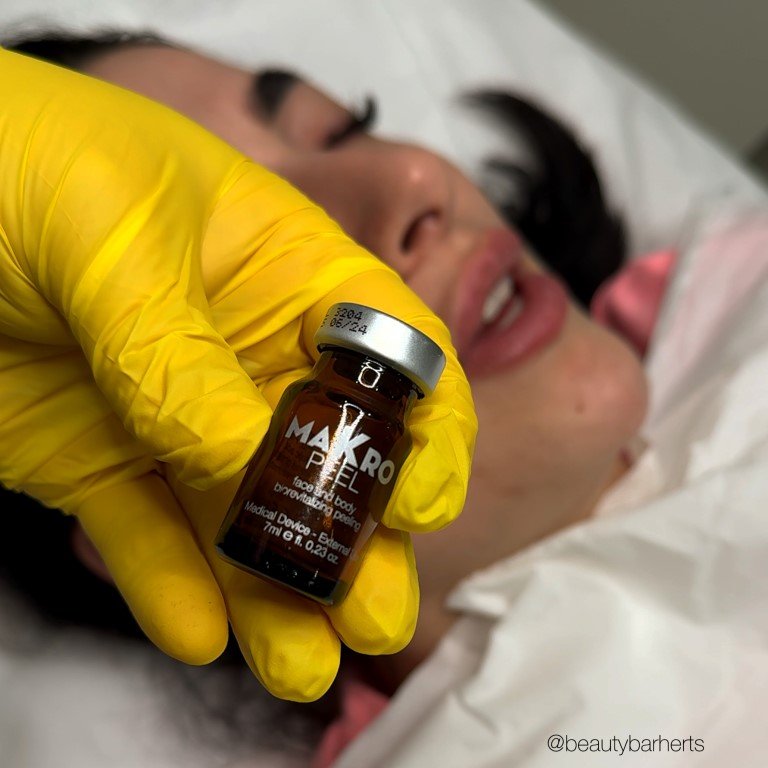
What skin concerns can chemical peels treat?
Chemical peel treatments are celebrated for their transformative powers, addressing an array of common skin concerns. Let’s uncover the magic behind chemical peels and explore the diverse skin issues they can effectively treat.
Chemical peels are renowned for their versatility. They are formulated to enhance and revitalize your skin by exfoliating the outermost layer. Depending on the type and depth of the peel, they can effectively target a wide range of skin concerns, unlocking your skin’s true potential.
One of the most celebrated benefits of chemical peels is their ability to reduce the appearance of wrinkles and fine lines. By stimulating collagen production and encouraging skin regeneration, peels can help you achieve a smoother, more youthful complexion.
Acne, a common and often distressing skin concern, meets its match in chemical peels. These treatments effectively combat acne by exfoliating clogged pores and reducing inflammation. The result? Clearer, blemish-free skin that lets your confidence shine.
Sunspots, age spots and uneven skin tone can mar an otherwise beautiful complexion. Chemical peels excel at reducing the appearance of these pigmentation irregularities, unveiling a more even-toned and radiant look.
Scars, whether from acne or other causes, need not be a lifelong concern. Chemical peels, particularly medium and deep peels, can reduce the visibility of scars, leading to a smoother skin texture.
If your skin has lost its lustre and appears dull, chemical peels can work wonders. These treatments help you regain a healthy, natural glow by removing the dead skin cells that can make your complexion appear lacklustre.
The beauty of chemical peels lies in their ability to be tailored to your specific needs. Whether you’re seeking a gentle refresh or a deep rejuvenation, there’s a chemical peel designed to address your unique skin concerns.
Chemical peels have the power to target wrinkles, acne, pigmentation issues, scars, and more, these treatments are a customizable solution for a diverse range of skin concerns. Discover your path to ageless, blemish-free, and radiant skin through chemical peels. Your beauty journey starts here.
How Many Sessions of Chemical Peels Do You Need?
Embarking on the journey to radiant, rejuvenated skin often comes with questions about the number of sessions needed for optimal results. We’ll provide insights into how many sessions may be required to achieve your desired skin transformation.
The number of chemical peel sessions you need is not a one-size-fits-all answer. It depends on several factors, including your skin concerns, the type of peel, and the depth of treatment. Let’s delve into these aspects to help you determine your path to radiant skin.
The first step is to identify your specific skin concerns and goals. Are you seeking wrinkle reduction, acne treatment, scar reduction, or skin rejuvenation? Each concern may require a different approach and number of sessions.
Chemical peels come in various strengths and pH levels, including superficial, medium, and deep peels. Superficial peels may require multiple sessions to achieve desired results, while deeper peels can often deliver significant improvements in just one session.
Everyone’s skin responds differently to chemical peels. Some individuals may see remarkable results with just one session, while others may require a series of 3 or 4 treatments to achieve their desired outcome. Factors such as skin type, age, and overall skin health play a role in how your skin responds to peels.
We will assess your skin and concerns, recommending a personalized treatment plan that outlines the number of sessions required. This plan will be designed to ensure the best possible results while considering your individual skin characteristics.
After your initial sessions, maintenance and follow-up treatments may be recommended to sustain the results and continue to improve your skin over time. These follow-up sessions are often less frequent than the initial series.
It’s crucial to understand that skin transformation takes time. Results from chemical peels are typically gradual and may become more noticeable with each session. Patience is key to achieving your desired outcome.
In conclusion, the number of sessions of chemical peels you need is a personalized journey. By identifying your specific skin concerns, consulting with an expert, and following a tailored treatment plan, you’ll be well on your way to revealing your most radiant self. Your path to glowing, youthful skin begins with the first step – booking your initial appointment.
What is the Downtime After a Chemical Peel? What can you expect after a chemical peel?
Downtime refers to the period following a chemical peel when you may experience some side effects as your skin undergoes the process of renewal and regeneration. The duration and intensity of downtime can vary based on the type and the strength of peel.
Minimal Interruption: Superficial, mild chemical peels are known for their minimal downtime. You may experience some redness and mild peeling, similar to a sunburn, which typically lasts for a few days. Many individuals can comfortably resume their daily activities immediately after this type of peel.
Moderate Downtime: Medium-strength chemical peels penetrate further into the skin, resulting in more noticeable improvements. With medium peels, you can expect redness, peeling, and possibly some swelling. Downtime typically lasts around one week. During this period, you may need to adjust your skincare and makeup routine to accommodate the healing process.
Deep Peels: Significant Results, Longer Downtime. Deep chemical peels offer the most dramatic improvements but come with the longest downtime. You may experience redness, proper peeling, which can persist for over a week. It’s crucial to follow post-treatment instructions meticulously and allow your skin the necessary time to heal.
Managing Downtime: While downtime can be an integral part of the skin transformation process, there are steps you can take to manage it effectively:
1. Follow Post-Treatment Care: Adhering to the recommended skincare regimen is crucial. This often includes gentle cleansing, moisturizing, and the use of sunscreen to protect your healing skin.
2. Avoid Sun Exposure: Protect your skin from direct sun exposure during downtime. Sunscreen is a must, and wearing a wide-brimmed hat and sunglasses can be beneficial.
3. Be Patient: Understand that downtime is temporary and part of the healing process. Your skin will gradually reveal its refreshed, more youthful appearance.
The duration of downtime is influenced by the type and depth of the chemical peel, as well as your individual skin characteristics. Before undergoing a chemical peel, it’s essential to consult with a skincare professional who will assess your skin and provide guidance on the expected downtime and aftercare. Downtime after a chemical peel varies based on the type and depth of the peel. While it is a temporary phase that allows your skin to rejuvenate, the benefits of a chemical peel can be transformative. By understanding and managing downtime effectively, you’ll be on your way to revealing radiant, refreshed skin.


Are there any Side Effects and Risks of Chemical Peels?
The appeal of chemical peels in the quest for radiant skin is undeniable, but the question of potential side effects and risks often arises. We’ll shed light on the essential facts about chemical peels, including what you need to know about potential side effects and risks.
Chemical peels are a time-tested cosmetic procedure designed to exfoliate the skin’s outermost layer, revealing a fresher, more youthful complexion beneath. They are categorized by strength or depth—superficial, medium, or deep—each offering a unique set of benefits and considerations.
As with any cosmetic treatment, chemical peels can have side effects, the nature and severity of which depend on the type and depth of the peel, as well as individual skin characteristics. Some common side effects may include:
Redness: After a chemical peel, it’s common to experience temporary redness, akin to a mild sunburn.
Peeling: As your skin renews itself, you may notice peeling. The degree of peeling varies depending on the depth of the peel.
Tightness: Some individuals may experience a sensation of skin tightness, or dry skin which usually subsides within a few days.
Swelling: Mild to moderate swelling can occur, especially with deeper peels, and typically diminishes within a few days.
Discomfort: While discomfort is generally minimal, some individuals may experience sensations of tingling or stinging during the procedure.
Risks and Considerations
While chemical peels are generally safe when performed by experienced professionals, there are specific risks and considerations to be aware of:
Hyperpigmentation: In rare cases, chemical peels may cause changes in pigmentation. To mitigate this risk, it’s crucial to follow post-treatment instructions and use sunscreen diligently.
Infection: Infections are rare but possible. Adhering to proper post-treatment care helps minimize this risk.
Scarring: Deeper peels carry a slightly higher risk of scarring, but this risk can be significantly reduced by choosing a skilled practitioner and diligently following aftercare instructions. Scars usually happen when people get impatient and try to pull on the peeling skin.
The key to a safe and successful chemical peel experience lies in consultation with a qualified skincare professional. They will assess your skin, discuss your goals, and recommend the appropriate type and depth of peel based on your unique needs.
Proper aftercare is essential for minimizing side effects and risks. Following your skincare professional’s recommendations, which often include gentle cleansing, moisturizing, sunscreen application, and avoiding sun exposure, is crucial.
Chemical peels offer transformative benefits for your skin, but it’s important to be aware of potential side effects and risks. By consulting with a skincare professional and adhering to recommended aftercare practices, you can experience the remarkable advantages of chemical peels while minimizing any associated risks. Your journey to radiant, youthful skin begins with knowledge and expertise.
The Power of Combining Chemical Peels with Microneedling and Mesotherapy
In the world of skincare and beauty, the pursuit of flawless, radiant skin often leads to a treasure trove of innovative treatments. But have you ever wondered about the potential of combining these treatments for even more exceptional results? Let’s explore the magical synergy of chemical peels, microneedling, and mesotherapy to unlock your skin’s true potential.
Chemical peels, microneedling, and mesotherapy are each renowned for their unique abilities to rejuvenate and transform the skin. When combined, they create a powerhouse trio that can address a diverse range of skin concerns.
Chemical peels, as you know, exfoliate the skin by removing the outermost layer, revealing a fresh, radiant complexion beneath. They effectively target concerns such as wrinkles, acne, and pigmentation issues. When combined with microneedling and mesotherapy, their transformative power multiplies.
Microneedling, a minimally invasive procedure, utilizes tiny needles to create micro-injuries in the skin. These controlled injuries stimulate collagen production, resulting in firmer, smoother skin. Combining microneedling with chemical peels amplifies the regeneration process, accelerating the emergence of youthful, radiant skin.
Mesotherapy involves the injection of a customized blend of vitamins, minerals, and other nutrients directly into the skin. This nourishes and revitalizes skin cells from within. When paired with chemical peels, mesotherapy further enhances the skin’s health and appearance, leading to a youthful, glowing complexion.
One of the remarkable aspects of combining these treatments is their customizability. Skincare professionals can tailor the combination to your unique skin type, concerns, and goals. Whether you’re seeking wrinkle reduction, acne treatment, or a rejuvenating glow, the combination can be adjusted to meet your specific needs.
When combined, chemical peels, microneedling, and mesotherapy work together to:
Boost Collagen Production: It stimulates collagen production, which leads to firmer, more youthful skin.
Exfoliate and Renew: Chemical peels exfoliate the skin, while microneedling and mesotherapy accelerate cell turnover and renewal.
Treat Multiple Concerns: The combination can effectively target a wide range of skin issues, from fine lines to pigmentation irregularities.
We will assess your skin, discuss your goals, and create a personalized treatment plan that outlines the combination most suited to your unique needs.
The combination of chemical peels, microneedling, or mesotherapy represents a remarkable breakthrough in the quest for youthful, radiant skin. By embracing these treatments, you unlock the potential to address multiple skin concerns and achieve results that surpass your expectations. Your path to ageless, glowing skin begins with the synergy of knowledge and expertise.
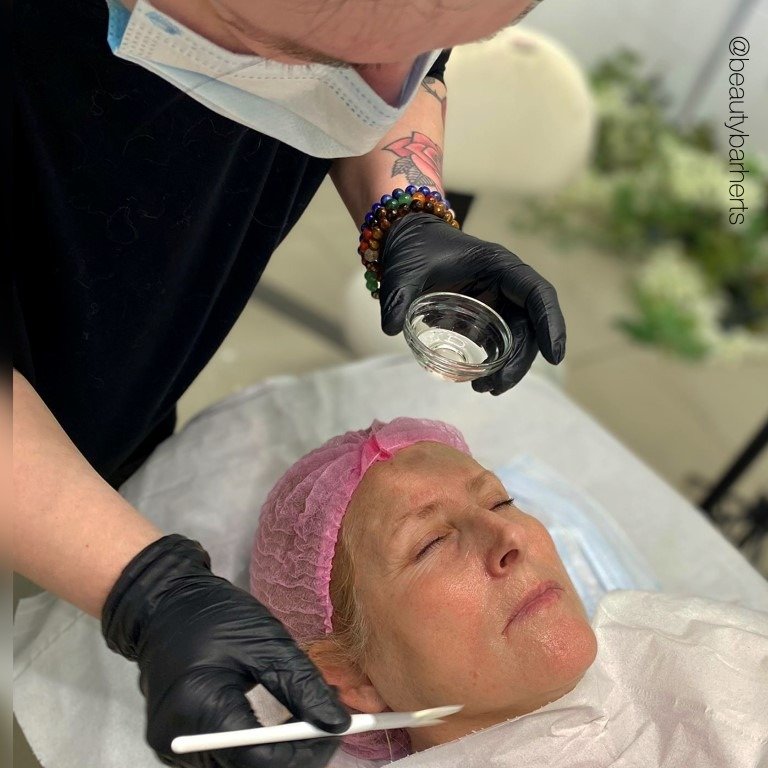
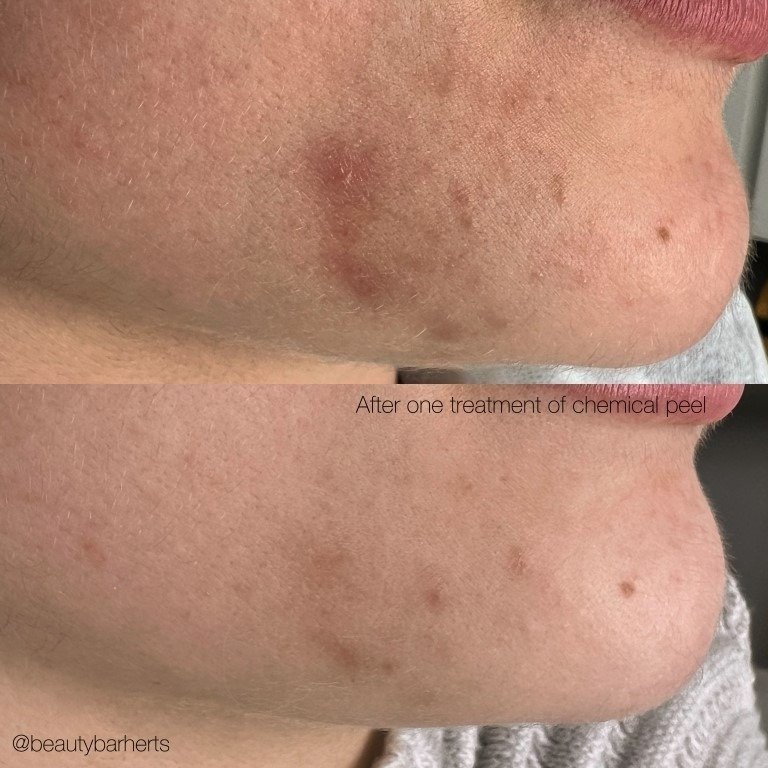
Radiant Skin for All: Are Chemical Peels suitable for Every Skin Type, Even the Sensitive?
Are chemical peels suitable for all skin types, including sensitive skin? We’ll uncover the secrets to achieving remarkable results with chemical peels, regardless of your skin type.
At the heart of the matter is understanding the science behind chemical peels. These treatments work by removing the skin’s top layer, revealing a fresher, more youthful complexion beneath. The question of suitability arises from the diverse range of skin types and concerns.
The beauty of chemical peels lies in their customizability. Skincare professionals can choose the correct type and depth of the peel to cater to your specific skin type and needs. This personalization is essential for ensuring a safe and effective treatment, especially for those with sensitive skin.
Sensitive Skin: A Unique Challenge
Sensitive skin requires special attention and care. It’s prone to redness, irritation, and discomfort when exposed to harsh treatments. The good news is that chemical peels can be adapted to suit sensitive skin, with modifications that reduce the likelihood of adverse reactions. It can even help with the skin to become less sensitive.
Mandelic chemical peel is often the best choice for sensitive skin. That gentle peel regulates sebum production and kills bacteria so is advised for acne and mature skin that is oily with breakouts. Perfect for sensitive, combination, oily skins, and skins with rosacea.
To ensure that chemical peels are suitable for your sensitive skin, it’s crucial to work with an experienced skincare professional. We will evaluate your skin type, assess your concerns, and recommend the most appropriate peel strength and formulation.
Post-treatment care is paramount, especially for sensitive skin. We will provide guidelines for gentle cleansing, moisturizing, and sun protection. Following these instructions diligently is essential for minimizing any potential side effects.
As with any skincare treatment, patience is key. The results from chemical peels, even for sensitive skin, are gradual and may become more noticeable with each session. A series of treatments are recommended to achieve your desired outcome.
Chemical peels are indeed suitable for all skin types, including sensitive skin. With the guidance of a skilled skincare professional and customized treatments, you can unlock the remarkable benefits of chemical peels while preserving the delicate balance of your sensitive skin. Your path to glowing, youthful skin begins with the power of knowledge and expertise.
What can I expect during a chemical peel treatment session?
The anticipation of radiant, rejuvenated skin often paves the way for curiosity about what to expect during a chemical peel treatment. We’ll take you on a journey through the transformative world of chemical peels, ensuring you’re well-prepared for this remarkable skincare experience.
Some procedures vary depending on the type of chemical peel.
Before the actual peel begins, your skincare professional will conduct assessment of your skin. This evaluation helps determine the most suitable type and depth of chemical peel for your unique needs and concerns. If you have sensitive skin, your practitioner will take that into account for a gentler approach. We usually try to determine the best treatment for you before your appointment, and some information may be gathered via email.
The treatment begins with a thorough cleansing of your skin. This step ensures that the peel solution can penetrate effectively and that your skin is free from impurities and oils. Some peels require a special solution to be applied before the treatment begins.
The actual peel application is a precise process. Your skincare professional will apply the specially formulated chemical solution to your skin. That can be done by a small brush, or small dots of products are applied from a syringe directly to your skin and then massaged in. The sensations during this stage can vary, with some individuals experiencing mild tingling or stinging and others saying it gives them light sensation of warm skin. For those with sensitive skin, the sensations are typically less intense.
The solution is left on your skin for a specific duration, determined by the type, pH and depth of the peel. Throughout this period, your practitioner will closely monitor your skin’s response to ensure that the desired outcomes are achieved while maintaining your comfort and safety.
At the appropriate time, the chemical solution is neutralized to stop the exfoliation process. This is a critical step in ensuring that your skin isn’t over-treated, and it’s done with precision to avoid any adverse reactions. Some peels require a special neutralising solution and others can be neutralsed by water.
Following the chemical peel, your skincare professional will provide you with guidelines for post-treatment care. This typically involves gentle cleansing, moisturizing, and the application of sunscreen. Proper aftercare is essential for minimizing side effects and ensuring the best results.
The side effects of a chemical peel can vary depending on the type and depth of the treatment. Superficial peels often have minimal downtime, while medium and deep peels may result in more pronounced redness and peeling, which can last for several days to a couple of weeks.
It’s essential to understand that the results of a chemical peel are gradual and noticeable with each session. Depending on your specific skin concerns and goals, a series of treatments are recommended.
By understanding the process and the steps involved, you can confidently embark on your journey to glowing, youthful skin. Your path to beauty and self-assurance begins with the expertise and guidance of a skincare professional.
How Long Do the Results of Chemical Peels Last?
In the quest for youthful, glowing skin, chemical peels have emerged as a transformative beauty secret. But one question often lingers in the minds of those considering this treatment: How long do the results of chemical peels. Let’s unveil the secrets behind the longevity of that radiant, refreshed complexion you desire.
The longevity of your chemical peel results depends on several key factors:
Type of Peel: The type of chemical peel used plays a significant role. Often milder peels with minimal downtime, may require more frequent sessions for long-lasting effects. In contrast, deep peels can offer longer-lasting results with fewer sessions.
Skin Type and Concerns: Your unique skin type and the specific concerns you aim to address influence how long the results will endure. Deeper wrinkles or stubborn pigmentation may require more maintenance.
Skincare Regimen: The skincare routine you follow post-treatment is crucial. Using quality products and protecting your skin from sun exposure can extend the life of your results.
While chemical peel results can be impressive, maintenance is the key to sustained radiance.
Here’s how to extend the longevity of your results:
Regular Sessions: Depending on your skin’s needs and the type of peel used, regular sessions may be recommended to maintain the desired effects.
Sun Protection: Shield your skin from UV rays with broad-spectrum sunscreen. Sun exposure can undo the benefits of your peel and lead to premature aging.
Quality Skincare: Invest in products tailored to your skin type and post-peel needs. Hydration, nourishment, and protection are essential.
A skincare expert can evaluate your skin, recommend the right treatments, and create a personalized plan to sustain your results.
The longevity of chemical peel results is influenced by several factors, including the type of peel, your skin type, and your post-treatment care. While chemical peels can yield remarkable results, their effects are not permanent. Maintenance and proper skincare are essential for preserving your radiant, rejuvenated skin.
Your path to timeless beauty begins with the power of knowledge and expertise.

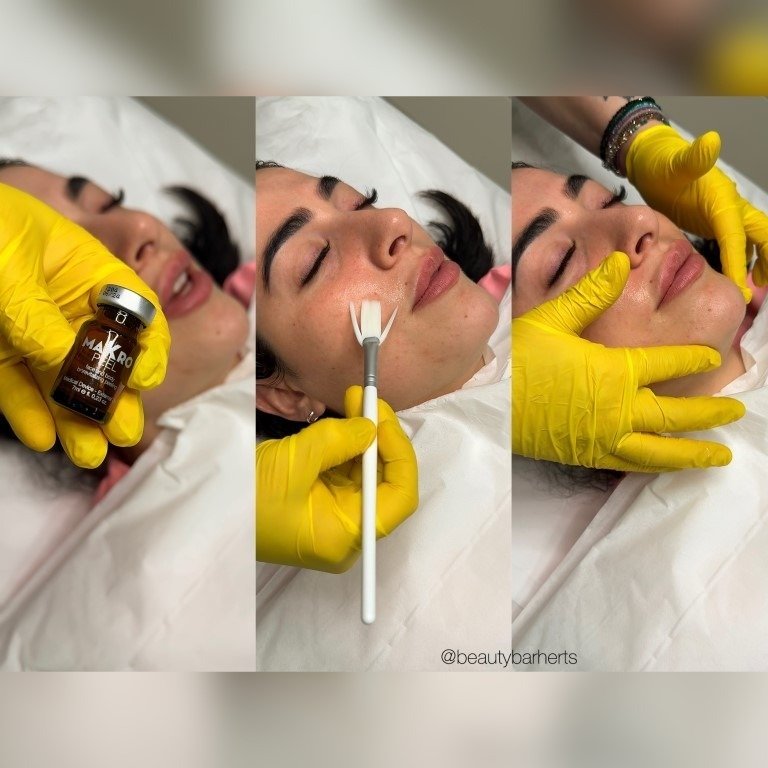
How often shall I get a chemical peel? The Ideal Frequency for Chemical Peel Sessions.
How often should you indulge in this transformative treatment to maintain that coveted glow? Let’s uncover the secrets behind the ideal frequency for chemical peel sessions to keep your skin vibrant and refreshed.
The longevity of your radiant complexion largely depends on how often you schedule your chemical peel sessions.
The Type of Chemical Peel:
Gentle Peels: These milder peels require more frequent sessions, typically a session every 1-2 weeks, to achieve desired results.
Medium and Deep Peels: These can provide longer-lasting results, often requiring sessions at intervals of a month for medium up to several months or even a year for deeper peels.
Skin Concerns and Goals: The specific concerns you want to address play a crucial role. Deeper wrinkles or stubborn pigmentation may need more frequent sessions.
Your Skin Type: Your unique skin type influences how often you should have chemical peels. Some individuals may need more frequent sessions than others.
Consistency is the key to preserving that radiant complexion. Here’s a roadmap to the ideal frequency for chemical peel sessions:
Start by consulting with a skincare expert who can assess your skin’s needs and recommend the right treatment plan.
Many individuals begin with a series of chemical peel sessions, scheduled at the recommended intervals for their peel type.
After your initial series, you may shift into maintenance mode. For superficial peels, this might mean sessions every 1-3 months, while deeper peels may require yearly appointments.
Skincare Regimen: In between sessions, a quality skincare regimen is essential to prolong the benefits and protect your skin from damage.
Sun Protection: Shield your radiant skin from UV rays with broad-spectrum sunscreen. Sun exposure can diminish the effects of your peel.
In conclusion, the ideal frequency for chemical peel sessions depends on the type of peel, your skin type, and your specific concerns. While chemical peels can offer remarkable results, they are not permanent, and consistency is key to maintaining that radiant glow as your skin ages.
Can Chemical Peels Erase Years from Your Face?
Aging gracefully is an art, and one of the most exquisite brushes in this masterpiece is the chemical peel. Can chemical peels truly turn back the hands of time, erasing years from your face? Let’s check the remarkable anti-aging potential of chemical peels, helping you discover the key to timeless beauty.
Before we dive into the remarkable possibilities, let’s understand the aging process. Over time, factors like sun exposure, lifestyle choices, and genetics manifest on our skin. Fine lines, wrinkles, uneven pigmentation, and dullness may take centre stage.
Chemical peels are renowned for their ability to rejuvenate and restore the skin. Here’s how they can help erase the years:
Exfoliation and Cell Renewal: Chemical peels exfoliate the skin’s top layer, removing dead skin cells. This stimulates the regeneration of fresh, youthful skin.
Collagen Production: The exfoliation process can trigger the production of collagen, a protein essential for skin elasticity and firmness.
Reducing Fine Lines and Wrinkles: Superficial peels can diminish fine lines, while deeper peels address more pronounced wrinkles.
Improving Skin Tone and Texture: Chemical peels can lighten pigmentation irregularities, even out skin tone, and reduce the appearance of scars.
Fighting Free Radicals: Some chemical peels contain antioxidants that combat free radicals, which can accelerate the aging process.
Discovering the anti-aging potential of chemical peels is just the beginning. Here’s how to embrace their transformative power:
1. Consult with an Expert: Start by consulting with a skincare professional who can assess your unique skin and recommend the ideal peel for your needs.
2. Tailored Treatment Plan: Craft a personalized treatment plan that may include a series of chemical peel sessions based on your concerns.
3. Quality Skincare: Maintain your radiant results with a quality skincare regimen that complements your peel treatment.
4. Sun Protection: Guard your renewed skin against the aging effects of UV rays by applying broad-spectrum sunscreen daily.
Chemical peels have the potential to turn back the clock, reducing the visible signs of aging. As you journey toward timeless beauty, the right chemical peel, combined with expert guidance and consistent care, can help you unveil an ageless version of yourself.
Unmasking the Science: How Do Chemical Peels Exfoliate and Revitalize Your Skin?
The science behind chemical peels is as fascinating as the radiant, revitalized skin they reveal. If you’ve ever wondered how these treatments work their magic, join us as we peel back the layers to unveil the exact science of chemical peels and their profound exfoliating and revitalizing effects.
At its core, a chemical peel is an exfoliation process, but it’s not your everyday scrub. It’s a precise, scientifically engineered treatment that targets and transforms your skin. Here’s how it works:
- Chemical peels utilize specialized formulas with active ingredients such as alpha hydroxy acids (AHAs), beta hydroxy acids (BHAs), or trichloroacetic acid (TCA).
- These formulas are applied to the skin, where they penetrate the epidermis, the outermost layer.
- Once inside the skin, the chemical peel initiates a process called “desquamation.” This is the detachment and shedding of the topmost layer of skin cells.
One of the key elements in the science of chemical peels is pH, or acidity. The pH level of a chemical peel solution is carefully calibrated to determine its depth and exfoliating strength:
Superficial Peels: These peels have a higher pH, making them milder. They work on the epidermis, effectively treating issues like fine lines, dry skin, and uneven pigmentation.
Medium Peels: With a slightly lower pH, medium peels target both the epidermis and the upper layer of the dermis. They can address more pronounced wrinkles and pigmentation.
Deep Peels: Deep peels have the lowest pH levels and can reach deeper into the dermis. They are designed for more significant issues such as deep wrinkles and scarring.
Cellular Regeneration
The magic doesn’t stop at exfoliation. The science of chemical peels stimulates a remarkable process:
Collagen Production: chemical peels prompt the production of collagen, a crucial protein for skin’s strength and elasticity.
New Skin Emerges: as the treated skin peels away, fresh, rejuvenated skin rises to the surface. This new skin is smoother, firmer, and more radiant.
The exact science of chemical peels revolves around precise formulas, pH levels, and cellular renewal. These treatments exfoliate and revitalize your skin by shedding old, damaged cells and promoting the growth of fresh, youthful skin.
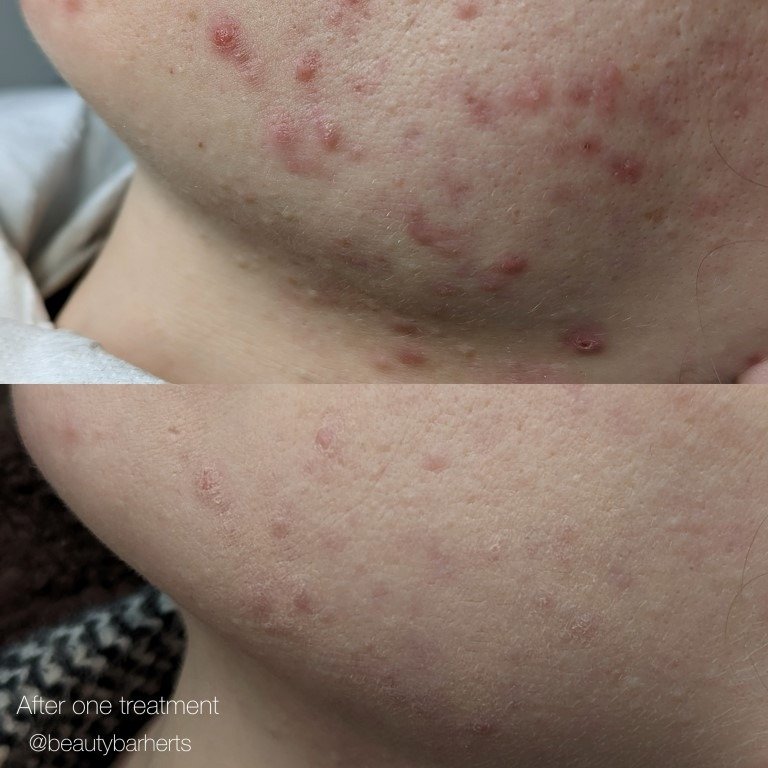

The Sun and Your Skin: Chemical peel Aftercare Essentials
Your fresh complexion is a canvas of renewed beauty, but it’s also more vulnerable to the sun’s unforgiving rays. Let’s explore the essential steps to safeguard your skin from UV damage after a chemical peel and the crucial aftercare practices that can help you maintain that radiant glow.
After a chemical peel, your skin is in a state of transformation. It’s more sensitive, the topmost layer of protection has been exfoliated, there’s no lipid layer to protect it.
Increased Sun Sensitivity: The exfoliation process leaves your skin more prone to sunburn and damage. It’s like removing your skin’s natural umbrella.
Risk of Hyperpigmentation: Sun exposure can lead to uneven pigmentation or dark spots in the newly revealed skin.
Safeguarding your skin is not only about avoiding the sun but also about embracing smart sun protection:
Sunscreen: Apply a broad-spectrum sunscreen with SPF 30 or higher. Make it a daily habit, even on cloudy days.
Protective Clothing: Wear wide-brimmed hats, sunglasses, and protective clothing to shield your skin from direct sun exposure.
Seek the Shade: When possible, stay in the shade, especially during peak sun hours.
Reapply Sunscreen: Reapply sunscreen every two hours or more frequently if swimming or sweating.
Avoid Tanning Beds: Tanning beds should be off-limits during the healing period and beyond.
The days following your chemical peel are a critical phase for nurturing your skin back to health. Here are some aftercare essentials:
Gentle Cleansing: Use a mild, gentle cleanser to avoid irritation. Pat your skin dry, never rub.
Hydration: Moisturize your skin to maintain its suppleness and prevent excessive dryness.
Avoid Harsh Products: Steer clear of harsh skincare products, including scrubs and products containing alcohol or irritants like e.g. vit c.
Patience with Peeling: It’s normal you may experience some skin shedding in the days following your peel. Refrain from picking or peeling the skin; let it naturally slough off.
Follow Professional Advice: Consult with your skincare professional about the right products and steps for your specific aftercare needs.
In conclusion, protecting your freshly-treated complexion from UV damage is a non-negotiable step in maintaining that radiant glow. By following sun protection strategies and adhering to gentle aftercare practices, your skin will not only heal beautifully but also retain its newfound youthful radiance.
The Art of Chemical Peels: Types and Their Skin-Transforming Magic
Chemical peels are like the secret potion of the beauty world, capable of addressing a spectrum of skin concerns. But did you know that different chemical peels are tailored to specific needs?
Before we unveil the magical treatments, let’s understand the science behind chemical peels. These treatments use various acid solutions to exfoliate the skin, revealing a fresh, revitalized complexion. The secret sauce lies in the choice of acids, their concentration, and the depth of penetration.
1. Superficial Peels: These are mild peels using alpha hydroxy acids (AHAs) like glycolic acid or beta hydroxy acids (BHAs) like salicylic acid. They’re perfect for improving skin texture, addressing fine lines, and mild pigmentation issues.
2. Medium Peels: TCA (trichloroacetic acid) peels fall into this category. They reach deeper into the skin and are excellent for treating more pronounced wrinkles, pigmentation, and scarring.
3. Deep Peels: Phenol peels are the heavy-hitters, penetrating deep into the skin. They’re ideal for significant issues like deep wrinkles and severe sun damage.
The Conditions They Treat
1. Superficial Peels: Fine Lines and Wrinkles, Dull Skin, Mild Acne Scarring, Uneven Skin Tone, Sun Damage
2. Medium Peels: Moderate Wrinkles, Pigmentation Irregularities, Acne Scars, Uneven Skin Texture, Sun Damage
3. Deep Peels: Severe Wrinkles, Deep Scars, Advanced Sun Damage, Precancerous Skin Growth Removal
The art of chemical peels involves matching the type of peel to your specific skin concerns. Whether you seek to address fine lines, sun damage, or severe scarring, there’s a chemical peel tailored to your needs.
TCA chemical peels: BIOREPEEL and PRX-T33
Biorepeel is an all-year-round medical peel, consisting of a complex of different acids (trichloroacetic, lactobionic, and salicylic), amino acids (proline, arginine, glycine), and vitamins C and B2, and will give an immediate effect of fresh-looking skin. This chemical peel is an excellent solution for people who are looking for a quick and non-invasive method to achieve beautiful and healthy skin. It reduces all imperfections without any side effects. Suitable for sensitive skin. We recommend a course of 4-6 treatments, each session 2 weeks apart.
PRX_T33 is also an all-year-round medical peel that contains TCA and kojic acid, making it perfect to treat discolouration.
What chemical peels do we offer at Beauty Bar?
Glycolic peel – Highly moisturizing, overall skin improvement, antiaging, brightening, works also on post-acne scars, acne, and stretch marks.
Salycylic peel – Anti-inflammatory, antibacterial, reduces sebum production. Acne vulgaris, blackheads, and whiteheads, papular acne, pustular acne (both noninflammatory and inflammatory), rosacea.
Mandelic peel – Regulates sebum production and kills bacteria so advised for acne and mature skin that is oily with breakouts. Perfect for sensitive, combination, oily skins, and skins with rosacea.
Lactic peel – Moisturising and stimulating. Advised for skins that are dry, dehydrated, acne-prone, premature skin aging, actinic keratosis.
Peruvic peel – Stimulates collagen production. Advised for oily skin, with acne, and blackheads, acne scars, aging skin.
Kojic peel – Antioxidant. For skin that’s aging and with discolouration and dark spots, sunspots, and pigmentation.
Azelaic peel – Different types of acne, discolouration, folliculitis.
Chemical Peel
Chemical Peel Treatment
Contact us and take your first step by booking your chemical peel appointment.
















